#nisayntang
Explore tagged Tumblr posts
Text
Love speculative biology

Selective breeding of viperhounds by the Txepiva clans
The Txepiva clans, also known in some parts as the Ash People, have no ikran and no pa'li. They are long distance runners and hunters, often on the move. Many of them are nomadic pastoralists, a practice unknown among the rest of the known Na'vi.
Their habitat, in turn bleak and burnt or rich and green, rarely forms anything close to a forest. The clans are always on the move, frequently fighting over territory, and yet regularly meeting with others in great gatherings. The largest, meant to reunite all the disparate Txepiva clans, is called the Tsawlultxa, and is the perfect opportunity to discover and study the stunning variety of Nìsayntang.
Just like mankind adopted wolves and turned them into dogs, the Txepiva adopted the plains' viperwolves. Millenia of selective breeding created the Nìsayntang, which the RDA catalogues as viperhounds.
Most neighbouring clans outside the Txepiva look down on breeding, preferring to go in the wild to capture their own mounts. We're left to understand it verges on taboo. As usual, the Txepiva seem to hardly care or take notice of their neighbours' distaste.
The relative isolation of each clan has allowed for the development of several subtypes of Nìsayntang.
Some clans have hounds whose forward arms have evolved to grab prey, while in others it's the secondary pair, with the elongated fingers of the hand coming back to fold over the rib cage in a position reminiscent of the stunbat's secondary arms.
Another clan breeds specifically for hunting in low light visibility.
Here are some examples of breeds of Nìsayntang!
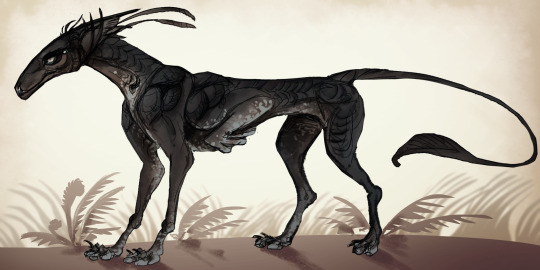
The most standard breed type, seen all across the plateaus and plains. They reach up to a Na'vi's knees or higher, much like a greyhound for humans. They're excellent runners and hunt as a pack, keenly aware of the Na'vi hunters movements. They can carry and manipulate objects with the prehensile limbs that have retracted against their chests. It's most commonly the middle pair of limbs, but as we'll soon see, some clans have bred hounds whose frontal limbs are the ones that evolved to hold and grab.
Nìsayntang are intelligent creatures, keen to help, and capable of understanding complex orders, especially through tsaheylu. This agile breed, quick on its feet, is favoured by the clans that raise srä‘etnaw (the livestock at the source of aforementioned pastoralism).
They'll assist their Na'vi with crafts, carrying things across the camp, leading scouting missions and reporting what they see, or for the best trained one, even hold the meat before it gets grilled! They also use their hands to grab stray srä‘etnaw pups and bring them back into the fold.
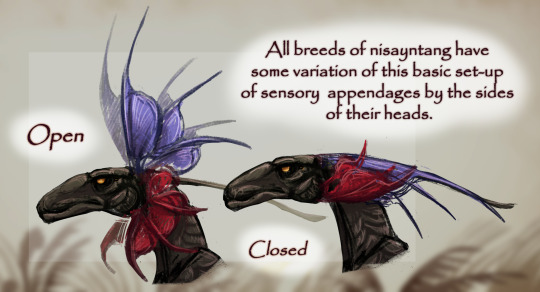
The facial appendages of Nìsayntang are flexible sensory organs. They help them sense their environment, but also play a major role in how they communicate between pack members. Think of the way wolves communicate with their ears, back on Earth.
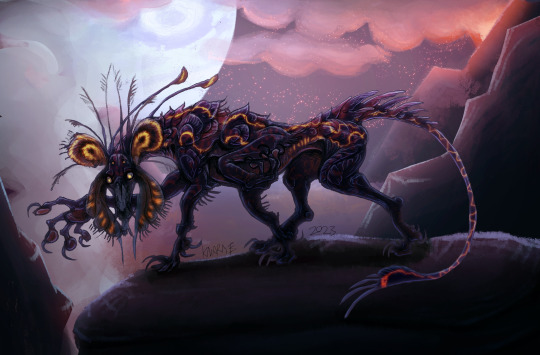

This variation is quite rare, and bred by a single tribe that favours night-time hunting and lives along black volcanic cliffs and lava fields. It's one of the darkest environments known in Pandora, especially during eclipse.
Their Nìsayntang have greater control of their natural bioluminescence, granting them better camouflage. Like a cuttlefish fooling its prey, they can modulate and increase the bioluminosity, creating alluring displays. The sensory strangeness causes their prey to freeze, equally curious and confused, and now vulnerable to ambush.
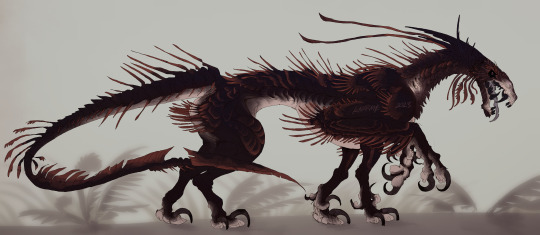
The stem-nisayntang were quite the genetically diverse and chaotic bunch, and the Na'vi of the Ash clans have been practising selective breeding on them for far longer than humans have with dogs.
This is an example of the aforementioned breeds in which it's the foremost limbs that have developed to extend and grab. It's the largest of the breeds presented in this study, as large to a Na'vi as a lion to humans, and aptly nicknamed "Leonin Hound" by first contact researchers. Their huge, heavy arms make them ambush predators, preferring bursts of speed and action to their cousins' long distance running. Their hands aren't as nimble or crafty, each fingers closer to sharp, robust talons.
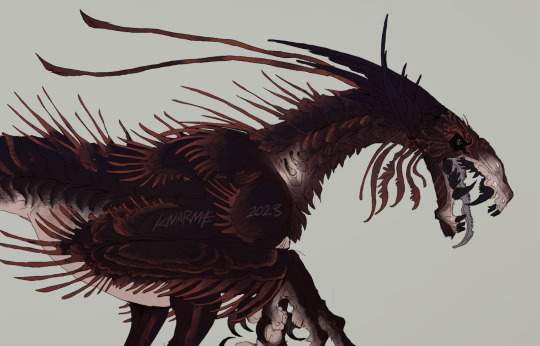
They have serrated teeth that tear through muscle and cartilage with unsettling ease. Their bite can even cut through most of the natural keratinous armour of Pandoran animals.
Their bodies are covered in bristles that help them sense vibrations in the air and ground. Those keen senses and efficient ambush tactics have gained them a reputation as “All-knowing guard hounds” among travellers who’ve met their keepers.
Despite the fearsome appearance and size, their pack mentality, as well as their ability to bond with their entire clan, make them desirable playmates for children, and it's not rare to see a couple of Txepiva youngsters tasked to guard toddlers and younger children, doing so with the help of their hounds. It's also quite common for them to ride on their back. Despite what a human might think of such a sight, it's as safe and natural to the Txepiva as riding an ilu as a child is for the Metkayina.
Bred to fend off the fearsome wildlife of the plains, the Leonin hounds are fiercely efficient at it and seem to have had their sense of fear bred right out of them. As such, they're one of the most widespread breeds in the plains. A handful of clans produce pups, and some are then traded at the great yearly Txepiva gathering. A clan might have their own specialised breed that has been living alongside them for untold generations, and still keep a couple of the Leonin hounds to help safeguard their camps.
Part I of @straydaddy (art and design) and @bluedaddysgirl (lore concept) in-world collaborative study, "Introduction to the Txepiva clans, their nomadic pastoralism and niche selective breeding practices in species of stingbats and viperwolves". On twitter we are Knarme and Bluedaddysgirl
#avatar#atwow#avatar 2#jc avatar#avatar fan lore#viperwolf#aliens#alien biology#xenobiology#xenozoology#speculative evolution#creature design#concept art#alien concept#speculative biology#na'vi#nisayntang#pandora
203 notes
·
View notes
Text

Selective breeding of viperhounds by the Txepiva clans
The Txepiva clans, also known in some parts as the Ash People, have no ikran and no pa'li. They are long distance runners and hunters, often on the move. Many of them are nomadic pastoralists, a practice unknown among the rest of the known Na'vi.
Their habitat, in turn bleak and burnt or rich and green, rarely forms anything close to a forest. The clans are always on the move, frequently fighting over territory, and yet regularly meeting with others in great gatherings. The largest, meant to reunite all the disparate Txepiva clans, is called the Tsawlultxa, and is the perfect opportunity to discover and study the stunning variety of Nìsayntang.
Just like mankind adopted wolves and turned them into dogs, the Txepiva adopted the plains' viperwolves. Millenia of selective breeding created the Nìsayntang, which the RDA catalogues as viperhounds.
Most neighbouring clans outside the Txepiva look down on breeding, preferring to go in the wild to capture their own mounts. We're left to understand it verges on taboo. As usual, the Txepiva seem to hardly care or take notice of their neighbours' distaste.
The relative isolation of each clan has allowed for the development of several subtypes of Nìsayntang.
Some clans have hounds whose forward arms have evolved to grab prey, while in others it's the secondary pair, with the elongated fingers of the hand coming back to fold over the rib cage in a position reminiscent of the stunbat's secondary arms.
Another clan breeds specifically for hunting in low light visibility.
Here are some examples of breeds of Nìsayntang!

The most standard breed type, seen all across the plateaus and plains. They reach up to a Na'vi's knees or higher, much like a greyhound for humans. They're excellent runners and hunt as a pack, keenly aware of the Na'vi hunters movements. They can carry and manipulate objects with the prehensile limbs that have retracted against their chests. It's most commonly the middle pair of limbs, but as we'll soon see, some clans have bred hounds whose frontal limbs are the ones that evolved to hold and grab.
Nìsayntang are intelligent creatures, keen to help, and capable of understanding complex orders, especially through tsaheylu. This agile breed, quick on its feet, is favoured by the clans that raise srä‘etnaw (the livestock at the source of aforementioned pastoralism).
They'll assist their Na'vi with crafts, carrying things across the camp, leading scouting missions and reporting what they see, or for the best trained one, even hold the meat before it gets grilled! They also use their hands to grab stray srä‘etnaw pups and bring them back into the fold.

The facial appendages of Nìsayntang are flexible sensory organs. They help them sense their environment, but also play a major role in how they communicate between pack members. Think of the way wolves communicate with their ears, back on Earth.


This variation is quite rare, and bred by a single tribe that favours night-time hunting and lives along black volcanic cliffs and lava fields. It's one of the darkest environments known in Pandora, especially during eclipse.
Their Nìsayntang have greater control of their natural bioluminescence, granting them better camouflage. Like a cuttlefish fooling its prey, they can modulate and increase the bioluminosity, creating alluring displays. The sensory strangeness causes their prey to freeze, equally curious and confused, and now vulnerable to ambush.

The stem-nisayntang were quite the genetically diverse and chaotic bunch, and the Na'vi of the Ash clans have been practising selective breeding on them for far longer than humans have with dogs.
This is an example of the aforementioned breeds in which it's the foremost limbs that have developed to extend and grab. It's the largest of the breeds presented in this study, as large to a Na'vi as a lion to humans, and aptly nicknamed "Leonin Hound" by first contact researchers. Their huge, heavy arms make them ambush predators, preferring bursts of speed and action to their cousins' long distance running. Their hands aren't as nimble or crafty, each fingers closer to sharp, robust talons.

They have serrated teeth that tear through muscle and cartilage with unsettling ease. Their bite can even cut through most of the natural keratinous armour of Pandoran animals.
Their bodies are covered in bristles that help them sense vibrations in the air and ground. Those keen senses and efficient ambush tactics have gained them a reputation as “All-knowing guard hounds” among travellers who’ve met their keepers.
Despite the fearsome appearance and size, their pack mentality, as well as their ability to bond with their entire clan, make them desirable playmates for children, and it's not rare to see a couple of Txepiva youngsters tasked to guard toddlers and younger children, doing so with the help of their hounds. It's also quite common for them to ride on their back. Despite what a human might think of such a sight, it's as safe and natural to the Txepiva as riding an ilu as a child is for the Metkayina.
Bred to fend off the fearsome wildlife of the plains, the Leonin hounds are fiercely efficient at it and seem to have had their sense of fear bred right out of them. As such, they're one of the most widespread breeds in the plains. A handful of clans produce pups, and some are then traded at the great yearly Txepiva gathering. A clan might have their own specialised breed that has been living alongside them for untold generations, and still keep a couple of the Leonin hounds to help safeguard their camps.
Part I of @straydaddy (art and design) and @bluedaddysgirl (lore concept) in-world collaborative study, "Introduction to the Txepiva clans, their nomadic pastoralism and niche selective breeding practices in species of stingbats and viperwolves". On twitter we are Knarme and Bluedaddysgirl
#avatar#atwow#avatar 2#jc avatar#avatar fan lore#fanart#viperwolf#space doggos#aliens#alien biology#xenobiology#xenozoology#speculative evolution#creature design#concept art#creature art#creature concept#alien concept#fan art#collaboration#alien design#alien creature#spec evo#spec bio#speculative zoology#speculative biology#na'vi#na'vi oc#nisayntang#pandora
203 notes
·
View notes